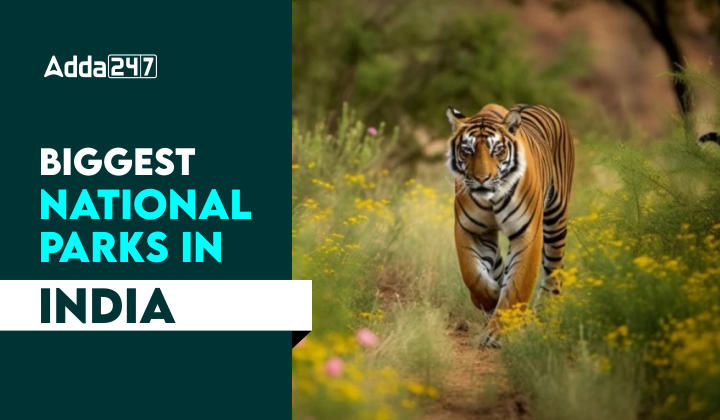A National Park is a designated area, typically under government ownership and management, with the primary mission of preserving and safeguarding its unique natural, cultural or historical attributes. These protected zones are created to ensure the preservation of distinctive ecosystems, landscapes and wildlife within their boundaries. Jim Corbett National Park, located in Uttarakhand, holds the distinction of being India’s first national park, established in 1963. In 1972, India introduced the Wildlife Protection Act, followed by the initiation of Project Tiger in 1973, both focused on conserving the habitats of species in need of conservation efforts. Presently, India boasts 106 national parks, covering a combined area of 44,378 sq. kilometers, equivalent to 1.35% of the nation’s total land area. In this article, we will delve into biggest national park in India.
Biggest National Parks in India
Hemis National Park is the biggest national park in India which covers an area of about 4,400 sq. km, established in 1981 in the state of Ladakh.
Here is the list of Top-10 Biggest National Parks in India:
| S. No. | Name | Area (in sq.km) | State | Year of establishment |
| 1. | Hemis National Park | 4,400 | Ladakh | 1981 |
| 2. | Desert National Park | 3,162 | Rajasthan | 1981 |
| 3. | Gangotri National Park | 2,390 | Uttarakhand | 1989 |
| 4. | Namdapha National Park | 1.,985.2 | Arunachal Pradesh | 1983 |
| 5. | Khangchendzonga National Park | 1,784 | Sikkim | 1977 |
| 6. | Guru Ghasidas (Sanjay) National Park | 1,440.7 | Chhattisgarh | 1981 |
| 7. | Sundarban National Park | 1,330.1 | West Bengal | 1984 |
| 8. | Indravati National Park | 1,258.4 | Chhattisgarh | 1975 |
| 9. | Papikonda National Park | 1,031 | Andhra Pradesh | 2008 |
| 10. | Kanha National Park | 940 | Madhya Pradesh | 1955 |
1. Largest National Park of India: Hemis National Park
- Establishment: 1981
- Area: 4,400 sq. km
- Location: Ladakh
Hemis National Park is a big place high up in the mountains of Ladakh, India. It is the largest national park of India and also considered as one of the biggest national park in the world. This national park is home to several species of endangered mammals and birds. Hemis National Park is a protected area for endangered mammals such as snow leopards, leopards, Asiatic ibex, Tibetan wolf, Eurasian brown bear and the red fox.
The park is famous as a habitat centre of Shapu or the Ladakhi Urial in the country. Some other small mammals are also found in this park like Himalayan marmot, mountain weasel and Himalayan mouse and a home to the birds like golden eagle, Lammergeier vulture and the Himalayan griffon. The suitable time to visit this national Park is between May and September.
2. Second Largest National Park in India: Desert National Park
- Establishment: 1981
- Area: 3,162 sq. km
- Location: Rajasthan
Desert National Park located in Thar Desert of Rajasthan, close to places called Jaisalmer and Barmer, is the second biggest national park in India with an area of about 3,162 sq. km. The Desert National Park consists of 20% sand dunes. This park is famous for the great Indian Bustard, which can be seen in large numbers here. This national park has a collection of rare fossils of animals and plants. The best time to visit Desert National Park is between November and January.
| Other Important Articles | |
| Largest State of India | Largest Flower in the World |
| Smallest Continent in the World | Largest Airport in the World |
3. India’s Third Largest National Park: Gangotri National Park
- Establishment: 1989
- Area: 2,390.02 sq. km
- Location: Uttarkhand
Gangotri National Park, located in Uttarkashi district of Uttarakhand, is the third largest national park of India. This national park is famous for the Gangotri glacier, the origin of Bhagirathi River. This national park is covered by dense coniferous forest and it is the home to the snow leopard. The weather of the park is good for rare species like black bears, brown bears, blue sheep, Himalayan tahr, Himalayan monal and Himalayan snowcock. Number of tourists came to visit the park from April to October.
4. Namdapha National Park
- Establishment: 1983
- Area: 1,985.2 sq. km
- Location: Arunachal Pradesh
Namdapha National Park, spanning 1,985 sq. km in Arunachal Pradesh, India, is a biodiverse hotspot in the Eastern Himalayas. Established in 1983, it hosts 1,000+ plant and 1,400+ animals species, including unique lowland rainforests at 27 degree North latitude. It is part of the Mizoram-Manipur-Kachin rainforests and ranks as India’s fourth-largest national park.
5. Khangchendzonga National Park
- Establishment: 1977
- Area: 1,784 sq. km
- Location: Sikkim
Khangchendzonga National Park, or Kanchenjunga Biosphere Reserve, in Sikkim, India, is a UNESCO World Heritage Site since 2016, regarded as India’s first “Mixed Heritage” site. It is a part of UNESCO’s Man and the Biosphere Programme, named after the majestic 8,586 m Kanchenjunga peak. Encompassing 1,784 sq. km, it is a treasure of biodiversity and natural beauty.
6. Guru Ghasidas (Sanjay) National Park
- Establishment: 1981
- Area: 1,440.7 sq. km
- Location: Chhattisgarh
Guru Ghasidas (Sanjay) National Park in Chhattisgarh’s Koirya district is a captivating sight, established in 1981 across 1,440.7 sq. km. The tropical Sakhua forest shelters diverse wildlife, including Bengal tigers, Indian leopards and varied bird species like golden hooded and racket-tailed drongos. This national park was renamed after Guru Ghasidas.
7. Sundarban National Park
- Establishment: 1984
- Area: 1,330.1 sq. km
- Location: West Bengal
Sundarban National Park, located in West Bengal, India, is renowned for its tiger and biosphere reserves. Established in 1984, it spans 1,330.10 sq. km across the Ganges Delta. Rich in biodiversity, it is home to Bengal tigers, diverse mammals, birds like openbill storks and reptiles including crocodiles. Designated a UNESCO World Heritage Site in 1987, it is a vital biosphere reserve since 1989.
8. Indravati National Park
- Establishment: 1975
- Area: 1,258.4 sq. km
- Location: Chhattisgarh
Indravati National Park, located in Chhattisgarh’s Bijapur district, named after Indravati river. It is a home to rare wild buffalo and diverse wildlife like nilgai, blackbuck and more. The park’s lush landscape boasts bamboo, sal and teak trees.
9. Papikonda National Park
- Establishment: 2008
- Area: 1,031 sq. km
- Location: Andhra Pradesh
Papikonda National Park, located near Rajamahendravaram in Andhra Pradesh, was established in 2008 across 1,031 sq. km. Known for its rich bird biodiversity, it shelters endangered species like Bengal tigers, Indian leopards and more. The park’s diverse forests host various deer species, gaur and antelope. It got recognition as an Important Bird and Biodiversity Area in 2016, with endangered birds like Oriental darters and River terns thriving there.
10. Kanha National Park
- Establishment: 1955
- Area: 940 sq. km
- Location: Madhya Pradesh
Kanha National Park, Madhya Pradesh’s largest at 940 sq. km, is renowned for its tiger reserve status. Established in 1955, it is a habitat for Bengal tigers, leapards, barasinghas and more. Rudyard Kipling’s ‘The Jungle Book’ drew inspiration from its lush forests. The park is a home to about 1,000 plant species and 300 bird species.
Find More General Studies News Here



 ODI World Cup winners full list (1975-20...
ODI World Cup winners full list (1975-20...
 Who was the First Governor of West Benga...
Who was the First Governor of West Benga...
 Pawan Sindhi Honored with Global Pride o...
Pawan Sindhi Honored with Global Pride o...
